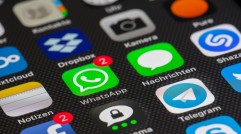30 Years After Macintosh, Does Apple Have the Same Core?
Most people wouldn't remember whether the Raiders or Redskins won Super Bowl XVIII, but they would remember one particular commercial that played that year. Thirty years ago, on Jan. 22, 1984, Apple Computer Inc.'s iconic Nineteen Eighty Four-inspired commercial aired for the Apple Macintosh, ushering in a new kind of desktop computer and declaring Apple's identity as a revolutionary smasher of conformist technology.
The Arrival of the Mac
Thirty years and many Macs later, does Apple have the same core?
The 1984 Macintosh commercial became iconic for several reasons beyond the later success of Apple, the company. First off, Ridley Scott, who had already created two enduring images of the future in Alien and Blade Runner, directed the Super Bowl ad. Secondly, the spot was based on the instantly recognizable imagery of the large screen with a talking head lording over emotionless plebeians that George Orwell's dystopian novel, 1984, had seared into every person who read it in grade school.
Finally, there's Anya Major, the Apple tank top-clad blonde who throws the sledge hammer into the screen, freeing the drones from the oppression of Big Brother (or "Big Blue" as then-popular PC manufacturer IBM was sometimes called). Following the climax, this tag line appeared on the screen: "On January 24th, Apple Computer will introduce Macintosh. And you'll see why 1984 won't be like '1984.'"
Apple paid a lot for the ad, which included 300 extras and obviously a lot of production work, but it paid off: Apple reached its 100-day goal for selling Macs by day 73, and by day 100 had sold as many as it could build. By the end of 1984, Apple had sold a quarter-million Macs.
A Revolution in Consumer Technology
But more importantly, the 1984 ad imprinted the image of Apple as a revolutionary computer company that built easy-to-use computers for individuals -- an image that Apple arguably lost in the years after it pushed Steve Jobs out of the company in 1985, regained after Jobs returned in 1997, and is in question now.
Of course, there are obvious differences in Apple, 2014 versus 1984. For one, it's no longer a struggling rebel fighting an empire of PCs run by IBM and Microsoft. Apple has sold 78 million modern Macs, according to MacWorld, has 422 Apple Stores worldwide, and serves an average of 1 million customers in the Apple Store per day.
In the intervening years, Apple has revolutionized several facets of the technology industry. The "iMac" (the "i" originally stood for internet, now it just goes before any Apple gadget name) arguably brought the internet to the desktop in an intuitive, easy to set-up way (especially considering dial-up at the time). The iPod, and its software iTunes certainly revolutionized, or even created, the digital music industry. And the iPhone brought the smartphone version of the mobile internet to those who had never used a BlackBerry or Palm.
Same Core?
But what is Apple's most recent revolution? The iPad was a big success, and now there are two generations of iPad minis and a lighter iPad. The 2013 iPhone has a fingerprint recognition button and a 64-bit processor. The latest MacBook Pros are really fast.
At least the 2013 Mac Pro has a completely rethought, never-before-seen design. At $3,000, the price seems a little steep, but compare that to the original $2,495 1984 Mac, which in today's dollars would cost about $5,595 and it seems reasonable.
But if Apple were to run the same type of ad for Super Bowl XLVIII, what would it be introducing, and who would be "Big Brother"? Samsung or Google's Android? Let us know in the comments what you think.
Subscribe to Latin Post!
Sign up for our free newsletter for the Latest coverage!













